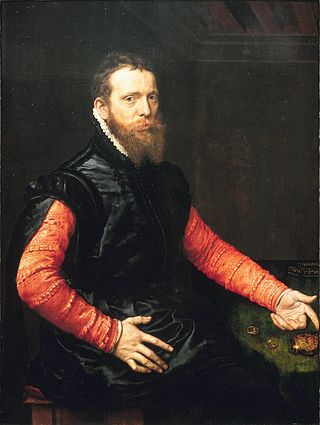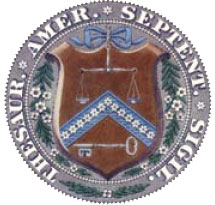Thomas Stanley (died 15 December 1571) was a goldsmith and officer of the Royal Mint in Tudor England. Stanley rose to the rank of Under-Treasurer of the Mint at the Tower of London in the reign of Queen Elizabeth I. [1]
Thomas Stanley (died 15 December 1571) was a goldsmith and officer of the Royal Mint in Tudor England. Stanley rose to the rank of Under-Treasurer of the Mint at the Tower of London in the reign of Queen Elizabeth I. [1]
Thomas Stanley was the third son of Thomas Stanley, of Dalgarth, Cumberland, and his wife Margaret, daughter of John Fleming. He married Joyce, daughter of John Barrett, of Aveley, Essex, and widow of Sir James Wilford, soldier and politician. Their only daughter, Mary, married Sir Edward Herbert (c. 1542–1595), second son of the Earl of Pembroke. [2] [3] Her son William Herbert, 1st Baron Powis (1572–1655) was Lord High Steward to Elizabeth I and is a candidate for "Mr WH", the dedicatee of Shakespeare's sonnets.
Stanley was appointed as one of the Assay Masters of the Mint in March 1545, following a restructuring and expansion of the Royal Mint under Henry VIII associated with a major effort to prop up the economy by debasing the currency. [4] The policy of debasement was continued by Lord Protector Somerset early in the reign of Henry's son, Edward VI, but after Somerset's fall the Earl of Warwick implemented a plan to reform the currency in an attempt to control rampant inflation. [5] Stanley was one of a consortium of Mint officials appointed in 1551 to advise the government on new standards for the coinage. [6] Another general restructuring of the Mint in the spring of 1552 resulted in the appointment of Thomas Egerton as Under-Treasurer and Stanley's promotion to Comptroller. [7]
Egerton was dismissed from office by Mary I's government in 1555, and from that time until 1571 control of the Tower Mint was essentially in the hands of Thomas Stanley. On the accession of Elizabeth he was confirmed as Comptroller of the Mint (August 1559) and he was formally appointed Under-Treasurer of the Mint on 14 July 1561, an office he held until his death. [8] [9] As head officer of the Tower Mint, Stanley supervised the great Elizabethan recoinage which was planned from the beginning of the reign and was carried out between December 1560 and October 1561. [10]
Disputes between Stanley and his fellow officers, Comptroller John Bull and assay-master William Humfrey, broke out in a series of accusations and cross-accusations over the next few years that escalated to a 1565 attempt by the two men to discredit Stanley by stealing money under his control. The plot was discovered and Bull confessed, but questions about Stanley's management of the Mint continued. His inability to properly account for his funds during the reign of Queen Mary led to the confiscation of his properties on 2 October 1571, and he died two months later, on 15 December 1571. [11]

The Royal Mint is the United Kingdom's official maker of British coins. It is the oldest company in the United Kingdom and is currently located in Llantrisant, Wales, where it moved in 1968.
Master of the Mint is a title within the Royal Mint given to the most senior person responsible for its operation. It was an important office in the governments of Scotland and England, and later Great Britain and then the United Kingdom, between the 16th and 19th centuries. Until 1699, the appointment was usually for life. Its holder occasionally sat in the cabinet.

The Coinage Act of 1792, passed by the United States Congress on April 2, 1792, created the United States dollar as the country's standard unit of money, established the United States Mint, and regulated the coinage of the United States. This act established the silver dollar as the unit of money in the United States, declared it to be lawful tender, and created a decimal system for U.S. currency.
William Humfrey (c.1515–1579) was an English goldsmith, mining promoter, and Assay Master at the Royal Mint during the reign of Elizabeth I.

The Trial of the Pyx is a judicial ceremony in the United Kingdom to ensure that newly minted coins from the Royal Mint conform to their required dimensional and fineness specifications. Although coin quality is now tested throughout the year under laboratory conditions, the event has become an annual historic tradition. Each year, thousands of coins are put on trial, consisting of both those struck for circulation and non-circulating commemorative coins.

The British sixpence piece, sometimes known as a tanner or sixpenny bit, was a denomination of sterling coinage worth 1⁄40 of one pound or half of one shilling. It was first minted in 1551, during the reign of Edward VI, and circulated until 1980. The coin was made from silver from its introduction in 1551 until 1947, and thereafter in cupronickel.

Edward Backwell was an English goldsmith-banker, and politician who sat in the House of Commons at various times between 1673 and 1683. He has been called "the principal founder of the banking system in England", and "far and away the best documented banker of his time".
Robert Richardson was a Scottish Prior of St Mary's Isle and royal administrator.
Sir Richard Martin was an English goldsmith and Master of the Mint who served as Sheriff and twice as Lord Mayor of the City of London during the reign of Elizabeth I.

Steven Cornelisz. van Herwijck, was a Netherlandish sculptor and gem engraver famous for his portrait medallions and medals. He spent two periods of his career in England, where he died. It has recently been suggested that he is the "famous paynter Steven" mentioned in an inventory of 1590, who has traditionally been identified as Steven van der Meulen.
Thomas Egerton was a London merchant and member of the Worshipful Company of Mercers.

Sir Martin Bowes was a very prominent and active civic dignitary of Tudor London whose career continued through the reigns of Henry VIII, Edward VI, Mary I and Elizabeth I. Born into the citizenry of York, Bowes was apprenticed in London and made his career at the Royal Mint, as a master-worker and under-treasurer, and personally implemented the debasement of English currency which became a fiscal imperative in the later reign of Henry.

The Great Debasement (1544–1551) was a currency debasement policy introduced in 1544 England under the order of Henry VIII which saw the amount of precious metal in gold and silver coins reduced and in some cases replaced entirely with cheaper base metals such as copper. Overspending by Henry VIII to pay for his lavish lifestyle and to fund foreign wars with France and Scotland are cited as reasons for the policy's introduction. The main aim of the policy was to increase revenue for the Crown at the cost of taxpayers through savings in currency production with less bullion being required to mint new coins. During debasement gold standards dropped from the previous standard of 23 karat to as low as 20 karat while silver was reduced from 92.5% sterling silver to just 25%. Revoked in 1551 by Edward VI, the policy's economic effects continued for many years until 1560 when all debased currency was removed from circulation.

The United States Assay Commission was an agency of the U.S. federal government from 1792 to 1980. Its function was to supervise the annual testing of the gold, silver, and base metal coins produced by the United States Mint to ensure that they met specifications. Although some members were designated by statute, for the most part the commission, which was freshly appointed each year, consisted of prominent Americans, including numismatists. Appointment to the Assay Commission was eagerly sought after, in part because commissioners received a commemorative medal. These medals, different each year, are extremely rare, with the exception of the 1977 issue, which was sold to the general public.

John Lonyson or Lonison (1525–1582) was an English goldsmith and Master of the Mint in the reign of Elizabeth I.

Thomas Fleetwood, of London, The Vache, Chalfont St. Giles, Buckinghamshire and Rossall, Lancashire, was an English politician. He was a Member of Parliament, a judge, and Master of the Royal Mint under King Henry VIII.
Eloy Mestrelle, first name sometimes spelled Eloye, was a French moneyer who was responsible for introducing milled coinage to England.
Peter Blondeau was a French moneyer and engineer who was appointed Engineer to the Royal Mint and was responsible for reintroducing milled coinage to England. He pioneered the process of stamping lettering onto the edge of coins.
John Acheson was a Scottish goldsmith, mining entrepreneur, and official of the mint.

James Mosman or Mossman was a Scottish goldsmith. He and his son John Mosman were supporters of the cause of Mary, Queen of Scots. James Mosman was executed in 1573 for counterfeiting coins in Edinburgh Castle. John Mosman carried letters for Mary, Queen of Scots, and was under surveillance by Francis Walsingham.